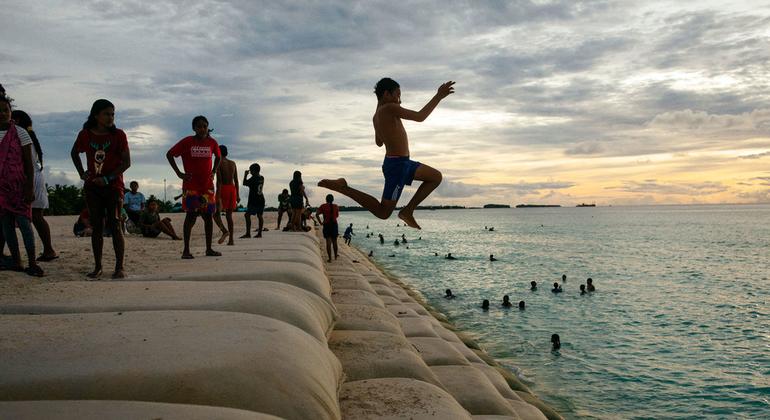What is sea level rise and why does it affect our future?

United Nations Secretary-General António Guterres visited the Pacific nations of Tonga and Samoa, where rising sea levels were one of the key issues he discussed with the communities he met.
On September 25, global leaders and experts will meet at the United Nations to discuss how best to tackle the threat.
Here’s what you need to know about rising sea levels:
High water level
It is estimated that sea levels have risen about 20–23 cm (8–9 inches) since 1880.
In 2023, the global average sea level hit a record high World Meteorological Organization of the United Nations (World Meteorological Organization) has been confirmed, according to satellite records kept since 1993.
What is worrying is that the rate of increase over the past 10 years is twice as fast as the rate of sea level rise in the first decade of satellite records, from 1993 to 2002.
What causes sea levels to rise?
Rising sea levels are the result of warming oceans and melting glaciers and ice sheets, phenomena that are direct consequences of climate change.
Even if global warming is limited to 1.5°C above pre-industrial levels, which is the goal set by countries around the world as part of Paris Agreement By 2015, sea levels on this planet will have risen significantly.
It is worth noting that ocean circulation patterns, such as the Gulf Stream, can lead to regional differences in sea level rise.

Rising sea levels are threatening tourism in places like St Lucia in the Caribbean.
What are the consequences?
Rising sea levels will have far-reaching impacts not only on the physical environment but also on the economies, societies and cultures of vulnerable countries around the world.
Saltwater flooding can harm coastal habitats, including coral reefs and fish stocks, agricultural land, and infrastructure, including housing, and can impact the ability of coastal communities to sustain their livelihoods.
Floods can contaminate freshwater sources, causing waterborne diseases that threaten human health and leading to stress and mental health problems.
At the same time, tourism revenue, an important economic driver, especially in many small island developing states (SIDS), could be affected as beaches, resorts and other tourist attractions such as coral reefs are damaged.
A combination of many factors can force people to leave their homes, move to higher ground if possible, or ultimately migrate, disrupting economies, livelihoods and communities.
Perhaps it is no surprise that UN Secretary-General Antonio Guterres described the phenomenon as “a growing threat”.
What is the link between rising sea levels and climate change?
Simply put, rising sea levels are a symptom of climate change.
As global temperatures rise due to climate change, the oceans absorb much of this excess heat. Warmer water increases in volume, a process known as thermal expansion, which is a major contributor to rising sea levels.
Rising sea levels also create a catastrophic feedback loop.
For example, mangroves, which protect coastal habitats and store harmful carbon dioxide that contributes to climate change, can quickly become overpopulated and lose their protective properties. Fewer mangroves mean more harmful gases in the environment, fueling climate change, and as temperatures rise, sea levels will rise even further.

Rising sea levels threaten global cities like New York.
Which countries are most affected?
It is estimated that about 900 million people, or one in every 10 people in the world, live near the sea.
People living in coastal areas of densely populated countries such as Bangladesh, China, India, the Netherlands and Pakistan will be at risk and likely to experience catastrophic flooding. Major cities on every continent are also at risk, including Bangkok, Buenos Aires, Lagos, London, Mumbai, New York and Shanghai.
Low-lying small islands are said to face the most serious threats. Rising sea levels and other climate impacts have already forced people to relocate in Pacific nations such as Fiji, Vanuatu and the Solomon Islands.

Women and girls fetch water after floods in Sindh province, southern Pakistan.
What can be done to combat rising sea levels?
The most consequential action that can be taken is to slow global warming by reducing greenhouse gas emissionsmajor cause of climate change.
Meanwhile, mitigating and adapting to rising sea levels has become more important than ever.
There are a variety of solutions, all of which are obviously costly, including: building infrastructure, such as sea walls and storm surge barriers, to protect against flooding and erosion; improving drainage systems and building flood-resistant buildings; restoring natural barriers such as mangroves; and protecting wetlands and coral reefs to absorb wave energy and reduce the impact of storm waves.
Many countries are also stepping up their disaster risk reduction plans as well as through UN-supported programmes. early warning system to address sea level issues.
In some cases, communities may also be relocated from vulnerable coastal areas as part of adaptation measures, an approach known as managed retreat.

Civil society organizations attending the United Nations climate talks in Dubai in 2023 are demanding compensation for loss and damage caused by climate change.
How the United Nations helps
Combating rising sea levels requires a comprehensive and coordinated international solution, and the United Nations is uniquely positioned to take the lead.
United Nations Framework Convention on Climate Change (United Nations Framework Convention on Climate Change (UNFCCC)) facilitate Paris Agreement to limit global warming, which is necessary to reduce future sea level rise.
The United Nations also provides support for SIDS and is working with the global community to provide exceptional financial support through Loss and damage fund to the most vulnerable countries and help them adapt to the impacts of climate change.
Learn more about how the United Nations is helping to tackle the challenge of rising sea levels This.




